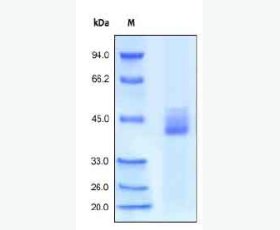Recombinant Human Lysine--tRNA Ligase/KARS
| Product name: | Recombinant Human Lysine--tRNA Ligase/KARS |
| Source: | Human Cells |
| Purity: | Greater than 95% as determined by reducing SDS-PAGE. |
| Buffer Formulation: | Supplied as a 0.2 μm filtered solution of 20mM TrisHCl,150mM NaCl,1mM DTT,20% glycerol,pH8.0. |
| Applications: | Applications:SDS-PAGE; WB; ELISA; IP. |
| Storage: | Avoid repeated freeze/thaw cycles. Store at 2-8 oC for one month. Aliquot and store at -80 oC for 12 months. |
| UOM: | 100ug/50ug/200ug/1mg/1g |
| Source | Human Cells |
| Description | Recombinant Human Lysine--tRNA Ligase is produced by our Mammalian expression system and the target gene encoding Ala2-Val597 is expressed with a 6His tag at the C-terminus. |
| Names | Lysine--tRNA Ligase, Lysyl-tRNA Synthetase, LysRS, KARS, KIAA0070 |
| Accession # | Q15046 |
| Formulation | Supplied as a 0.2 μm filtered solution of 20mM TrisHCl,150mM NaCl,1mM DTT,20% glycerol,pH8.0. |
| Shipping |
The product is shipped on dry ice/ice packs. |
| Storage |
Store at < -20°C, stable for 6 months after receipt. Please minimize freeze-thaw cycles. |
| Purity |
Greater than 95% as determined by reducing SDS-PAGE. |
| Endotoxin | Less than 0.1 ng/µg (1 IEU/µg) as determined by LAL test. |
| Amino Acid Sequence |
AAVQAAEVKVDGSEPKLSKNELKRRLKAEKKVAEKEAKQKELSEKQLSQATAAATNHTTDNGVGP EEESVDPNQYYKIRSQAIHQLKVNGEDPYPHKFHVDISLTDFIQKYSHLQPGDHLTDITLKVAGR IHAKRASGGKLIFYDLRGEGVKLQVMANSRNYKSEEEFIHINNKLRRGDIIGVQGNPGKTKKGEL SIIPYEITLLSPCLHMLPHLHFGLKDKETRYRQRYLDLILNDFVRQKFIIRSKIITYIRSFLDEL GFLEIETPMMNIIPGGAVAKPFITYHNELDMNLYMRIAPELYHKMLVVGGIDRVYEIGRQFRNEG IDLTHNPEFTTCEFYMAYADYHDLMEITEKMVSGMVKHITGSYKVTYHPDGPEGQAYDVDFTPPF RRINMVEELEKALGMKLPETNLFETEETRKILDDICVAKAVECPPPRTTARLLDKLVGEFLEVTC INPTFICDHPQIMSPLAKWHRSKEGLTERFELFVMKKEICNAYTELNDPMRQRQLFEEQAKAKAA GDDEAMFIDENFCTALEYGLPPTAGWGMGIDRVAMFLTDSNNIKEVLLFPAMKPEDKKENVATTD TLESTTVGTSVVDHHHHHH
|
| Background | Lysine-tRNA ligase, also known as Lysyl-tRNA synthetase, LysRS, KARS and KIAA0070, belongs to the class-II aminoacyl-tRNA synthetase family. The N-terminal cytoplasmic domain (1-65) is a functional tRNA-binding domain, which is required for nuclear localization, is involved in the interaction with DARS, but has a repulsive role in the binding to EEF1A1. A central domain (208-259) is involved in homodimerization and is required for interaction with HIV-1 GAG and incorporation into virions. KARS catalyzes the specific attachment of an amino acid to its cognate tRNA in a two step reaction: the amino acid (AA) is first activated by ATP to form AA-AMP and then transferred to the acceptor end of the tRNA. Defects in KARS are the cause of Charcot-Marie-Tooth disease recessive intermediate type B (CMTRIB). |














